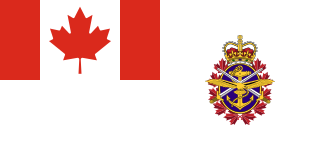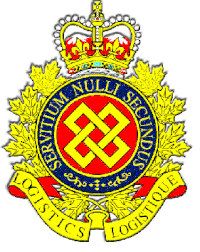
The Portuguese Armed Forces are the military of Portugal. They include the General Staff of the Armed Forces, the other unified bodies and the three service branches: Portuguese Navy, Portuguese Army and Portuguese Air Force.
Corps is a term used for several different kinds of organization. A military innovation by Napoleon I, the formation was first named as such in 1805. The size of a corps varies greatly, but two to five divisions and anywhere from 40,000 to 80,000 are the numbers stated by the US Department of Defense.

The Canadian Armed Forces are the unified military forces of Canada, including land, sea, and air commands referred to as the Canadian Army, Royal Canadian Navy, and the Royal Canadian Air Force. The CAF also operates several other commands, including the Canadian Forces Intelligence Command, the Canadian Joint Operations Command, and the Canadian Special Operations Forces Command.
This is a table of the ranks and insignia of the Canadian Armed Forces. As the Canadian Armed Forces is officially bilingual, the French language ranks are presented following the English.
Canadian Forces Base Borden, formerly RCAF Station Borden, is a large Canadian Forces base located in Ontario. The historic birthplace of the Royal Canadian Air Force, CFB Borden is home to the largest training wing in the Canadian Armed Forces. The base is run by Canadian Forces Support Training Group (CFSTG) and reports to the Canadian Defence Academy (CDA) in Kingston.
Chief Warrant officer is a senior warrant officer rank, used in many countries.

A combat medic is responsible for providing emergency medical treatment at a point of wounding in a combat or training environment, as well as primary care and health protection and evacuation from a point of injury or illness. Additionally, medics may also be responsible for the creation, oversight, and execution of long-term patient care plans in consultation with or in the absence of a readily available doctor or advanced practice provider. Combat medics may be used in hospitals and clinics, where they have the opportunity to work in additional roles, such as operating medical and laboratory equipment and performing and assisting with procedures.

The Royal Canadian Medical Service is a personnel branch of the Canadian Armed Forces, consisting of all members of medical occupations. Nearly all members of the RCMS, along with the members of the Royal Canadian Dental Corps (RCDC), are employed in the Canadian Forces Health Services Group, an operational formation. The RCMS was formerly designated the Canadian Forces Medical Service until it was redesignated on October 9, 2013.

Personnel branches, in the Canadian Armed Forces (CAF), are groupings of related military occupations.

The Corps of Royal Canadian Electrical and Mechanical Engineers (RCEME) is a personnel branch of the Canadian Armed Forces (CF) that provides army engineering maintenance support. All members of the corps wear army uniform. From the 1980s to 2013 it was called the Electrical and Mechanical Engineering Branch.

The Music Branch is a personnel branch of the Canadian Armed Forces (CAF). It is primarily composed of band musicians, and also deals with the selection and musical training of its recruits. The branch encompasses all the military bands in service in the Canadian Armed Forces. It is roughly the equivalent to the British Army's Royal Corps of Army Music (CAMUS).
The Royal Canadian Army Pay Corps (RCAPC) was an administrative corps of the Canadian Army with its own cap badge, and other insignia and traditions. It was established in 1906 as the Canadian Army Pay Corps. It was responsible for administering all financial matters.

The Royal Canadian Dental Corps is a personnel branch of the Canadian Armed Forces (CAF). Most members of RCDC, along with the members of the Royal Canadian Medical Service, are employed in the Canadian Forces Health Services Group within the Military Personnel Command reporting to the Chief of Military Personnel. All members of RCDC wear Army uniform. The branch was first raised in 1915 as the Canadian Army Dental Corps and was known from 1947 until 1968 as The Royal Canadian Dental Corps. From 1968 to 2013 the branch was previously named the Dental Branch.
A logistics officer is a member of an armed force or coast guard responsible for overseeing the support of an army, air force, marine corps, navy or coast guard fleet, both at home and abroad. Logistics officers can be stationary on military bases or deployed as an active part of a field army, air wing, naval force or coast guard fleet. The responsibilities of Logistics Officers vary, depending on where they are deployed and what tasks they are assigned. In addition, different countries have different roles for Logistics Officers. The main role of these officers remains the same regardless of where they are stationed; to ensure that the force is supplied with enough food, water, fuel, ammunition and other goods and services to complete the task at hand.

Troops began wearing berets as a part of the headgear of military uniforms in some European countries during the 19th century; since the mid-20th century, they have become a component of the uniforms of many armed forces throughout the world. Military berets are usually pushed to the right to free the shoulder that bears the rifle on most soldiers, but the armies of some countries, mostly within Europe, South America, and Asia, have influenced the push to the left.

The unification of the Canadian Armed Forces took place on 1 February 1968, when the Royal Canadian Navy, Canadian Army, and Royal Canadian Air Force were merged to form the Canadian Armed Forces.
In the Royal Canadian Navy, the rank of lieutenant(N) (Lt(N)) (French: Lieutenant de vaisseau) is the naval rank equal to captain in the army or air force. When the naval rank lieutenant is written or typed, it is followed by the letter N to indicate that it is a naval rank to distinguish it from army and air force lieutenants (and therefore, the (N) remains silent as it must not be pronounced or replaced by the word (Navy)). Lieutenants(N) are senior to sub-lieutenants and to army and air force lieutenants, and are junior to lieutenant-commanders and majors.

33 Service Battalion is a Canadian Forces Primary Reserve unit with three companies located in northern and eastern Ontario - at the M.L. Troy Armoury in North Bay, Pine Street Armoury in Sault Ste Marie, and the Major Holland Armoury in Ottawa. The battalion is under command of 33 Canadian Brigade Group, itself commanded by the 4th Canadian Division. The battalion is made up of officers and soldiers primarily from the Royal Canadian Logistics Service and the Royal Canadian Electrical and Mechanical Engineers providing Combat Service Support to 33 Canadian Brigade Group and other military organizations in eastern and northern Ontario - by means of transportation, supply, administration, food services, and mechanical repair and recovery activities.
Logistic Specialist is the Royal New Zealand Army Logistic Regiment trade responsible for providing Supply & Quartermaster support to the New Zealand Army within New Zealand or overseas.
The Indonesian Army Logistics and Transportation Center is a sustainment – formerly combat service support (CSS) – agency of the Indonesian Army. Its primary missions are supporting the development, production, acquisition, and sustainment of general supply, mortuary affairs, subsistence, petroleum and water, material and distribution management during peace and war and in support of civil disaster relief. It is also tasked with providing combat logistics and equipment, personnel and materiel transport services over any terrain on land, rail, air and sea in coordination with the other service branches of the Indonesian National Armed Forces.










